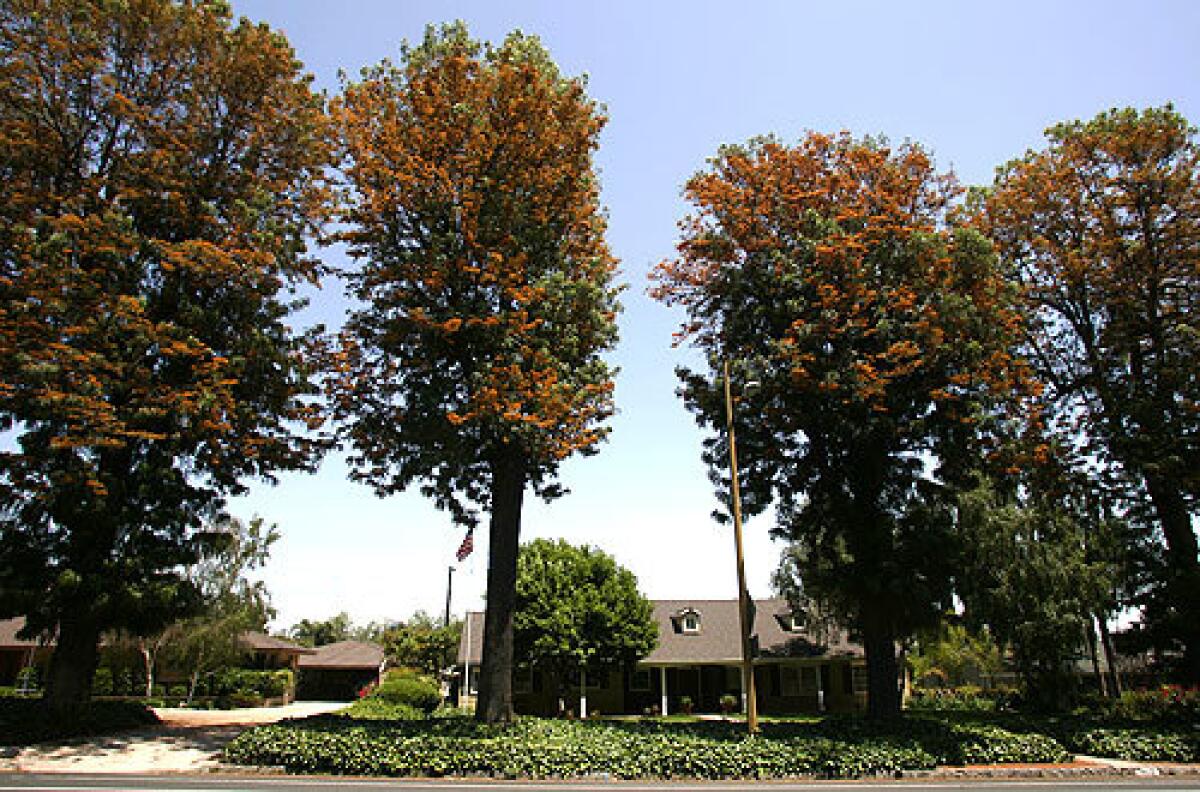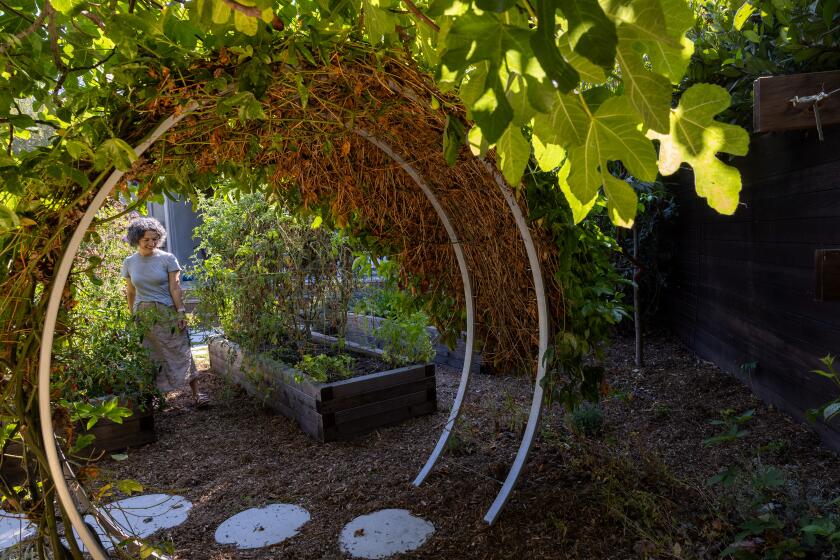Silk oak, a towering beauty that’s a bit of a wallflower

IT’S the flowering, towering tree that’s blooming all over town right now. Few know its name or how it came to settle alongside so many freeways and on city streets. With its showy orange-gold blooms and fern-like leaves, the silk oak just may be L.A.’s best-known unknown tree.
In fact, if it were a person, you might feel sorry for this Australian transplant, with its odd mix of traits that make it beloved by some, disliked by others, but for the most part ignored — even by ardent tree people, who rank it fairly low in the catalog of local botanical beauties. But for others, the silk oak (Grevillea robusta) is a familiar presence, a reminder of spring — and perhaps of home.
“I adore the silky oak,” says Australia native Jo O’Connell, owner of the Australian Native Plants Nursery in Ventura, referring to it by its popular name Down Under. “It’s a lovely tree, and I’ll stand up for it. I know it’s messy and it drops a lot of leaves, especially in spring before it begins to flower. But it has such a beautiful leaf. In China, the leaves are used for treating cuts and scratches. And it has those beautiful, spidery flowers. I love them, and so do the orioles and hummingbirds.”
The silk oak also has its complement of vocal fans around the world, some of whom write love notes to it on the Internet.
On the Dave’s Garden website, for example, one person from Adelaide, Australia, writes that the “beautiful, brilliant yellow orange flowers bear prodigious amounts of nectar, which may be collected by briskly shaking flowers into a bucket. If you suck on the flower, you get a tasty few drops.”
A writer from Houston thought her little silk oak was a houseplant until she moved it outside. “It’s now 25 feet tall and 20 feet wide. It has bloomed six years in a row. It’s so gorgeous,” she coos.
Still, there are some who might argue that a love for the silk oak is something of an acquired taste.
“It’s an OK tree,” says Frank McDonough, in the verbal equivalent of a yawn. McDonough is the botanical information director at the Los Angeles County Arboretum, where the tree is on display.
“It’s not an attention-grabber, especially when it’s not in flower,” he says. “It doesn’t have the spectacular shape some other trees have.” Although it grows to 80 feet tall, it fades into the background compared with such iconic L.A. show-stoppers as purple jacaranda, white magnolia and golden trumpet trees.
Plus, it is too tall to plant in most yards, McDonough says. Its branches droop instead of spreading into a lush halo of green. They are brittle and tend to break off in stiff winds. The tall stack of recently fallen branches beside the arboretum’s specimen illustrates his point.
Its speedy growth and lofty height mean the tree must be topped frequently in home gardens. Its brilliant blooms, which look so attractive from afar, are sort of bizarre up close, McDonough says. “For want of a better description, each spiny flower looks something like a hair comb,” he says. “The flowers tend to orient horizontally, so you get these upside-down mustaches of orange gold all over the tree.”
Calls to local nurseries reveal that some don’t carry the tree because it’s not requested much; those who do offer it have few in stock.
For her part, O’Connell doesn’t grow a lot of the trees to sell in her nursery, she says, because the plant is such a fast riser that it often outgrows its pot before it’s sold. But she loves the silk oak as an indoor plant.
“In Australia we grow them in atriums and other indoor rooms,” she says. “By growing them in a container you can prune them a lot and really hold down their size. And if they do get too large, you can donate them to a friend who has more space than you.”
Grevillea robusta was first imported by Australians who came to California during the Gold Rush, McDonough says. Because the tree flourishes in full sun and well-drained soil, it settled easily into Southern California, where its winged seeds are spread on the wind.
One of the most interesting planned plantings of the silk oak is in Upland. There, the city’s founding Chaffey family designed a broad main boulevard, Euclid Avenue, with a center median on which they planted silk oak, selected for its beauty and resistance to heat and drought.
The trees are still there, a botanical complement to a lovely area. It’s one of the few places in Southern California where locals gaze proudly at these oddly configured trees, and almost everyone knows their name.
*






